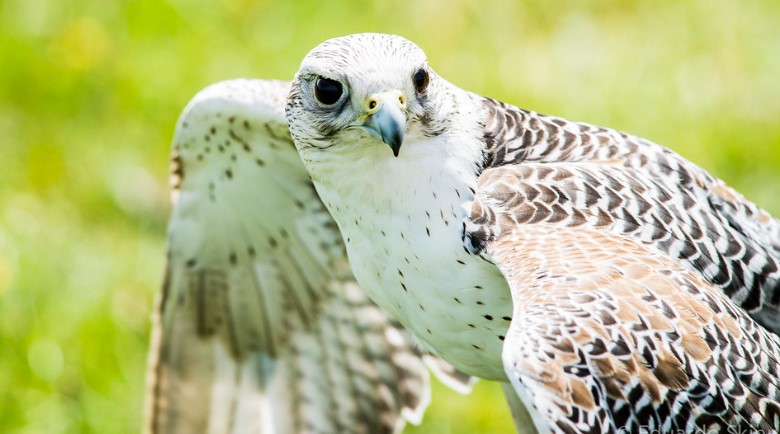The Gyr Falcon (Falco rusticolus) is a large and powerful bird of prey known for its impressive size and hunting abilities. The Gyr Falcon is a large bird of prey, with a length of 50 to 60 cm and a wingspan of 110 to 140 cm, making it the largest and most powerful falcon. Its wingspan is comparable to that of the common buzzard.
The Gyr Falcon is much larger than most Peregrines, but the smallest males are still smaller than the largest female Peregrines of the northern race calidus. This falcon is known for its slow and shallow yet powerful wing beats, which are faster and deeper during the pursuit. It usually hunts at low altitudes, taking most of its prey on the ground and stooping much less frequently than the Peregrine.
When soaring, the Gyr Falcon holds its wings flat, with the tips slightly upturned. There are three recognized morphs, but many intermediates exist. The distinctive white morph is rare in our region. The gray morph has underparts similar to the dark morph, but the upper parts are paler and grayer, with prominent whitish feather edges giving it a scaly appearance. The white morph is unmistakable.
The number of dark markings varies greatly, with some adults having few markings and others having many. The dark morph and gray morph differ from the Peregrine in flight outline, having a longer tail with a broader base, a heavier body, and long wings with broader bases and a more rounded tip.

The upper part color is slate-grey in the dark morph and pale gray in the gray morph. The Gyr Falcon has a narrower moustachial streak than the Peregrine. This streak is less noticeable in the dark morph by fine dark streaks that partially obscure the pale cheek patch. The gray morph is paler than any Peregrine, and the whitish feather edgings give it a scaly appearance on the upper parts and upper wing coverts. The gliding Northern Goshawk may resemble the Gyr Falcon, but its shorter, broader, and more rounded wings will soon reveal its true identity.
The juvenile dark and gray morphs of the Gyr Falcon resemble the juvenile Peregrine of the nominate and southern races in their largely dark brown appearance. However, they can be differentiated by the same structural differences as adults and by a narrower moustachial streak (less noticeable by dark streaks that obscure the pale cheek patch). Distinguishing the juvenile calidus Peregrine based on plumage is more challenging, as it can be quite light on the forehead, crown, and nape and has lighter brown upper parts and wing coverts with more noticeable pale fringes.
The juvenile dark morph typically displays a noticeable contrast between the heavily spotted underwing coverts and the pale flight feathers (not present in the Peregrine); the moustachial streak is less defined (the pale cheek patch of the calidus is more visible, making the moustachial streak stand out); and the forehead and crown are never light, although a pale nape patch is present.
The juvenile grey morph can be similar to some calidus, and the best way to differentiate is by shape or size if the assessment is possible. The juvenile dark morph differs from the adult dark morph in being even darker and browner (less gray) on top with a more noticeable pale nape patch; the underparts are more heavily marked with dark, longitudinal streaks; the underwing coverts are largely dark in contrast to the paler flight feathers; and the moustachial streak is bolder but can appear less noticeable due to finely streaked cheeks.
The juvenile gray morph resembles the adult gray morph but is darker and browner above. The juvenile white morph is darker on top with denser markings on the mantle, wings, and tail, and the underside is also more heavily marked with noticeable dark markings on the flight feathers, tail, and breast. All morphs have grayish ceres and legs, not yellow.
Due to significant color variations in most of its range, no races of the species are recognized. The breeding birds in the European region are mostly dark or gray, with the former being predominant in Scandinavia and Northern Russia and the latter in Iceland. The white morph is a rare sight in northern Russia and only appears as a vagrant from northern Greenland.
The Gyr Falcon is a scarce bird, primarily found in open tundra and arctic or sub-arctic mountains, river valleys with crags, and sea cliffs. During the winter months, it can also be found in extensive forest clearings, cultivated areas, and coastal marshes.
Historically, the Gyr Falcon was highly prized for its hunting abilities and was trained and used for hunting by royalty and the wealthy. The bird was so valuable that it was often given as a gift between rulers and was even used as a currency in some cultures. In modern times, the Gyr Falcon is still used for hunting in some countries, under protected laws in many places to ensure its survival.
In areas where it is protected, the Gyr Falcon is valued for its beauty and its role as a top predator in the ecosystem. Some people also keep Gyr falcons as pets, but this requires a special permit and the proper care and facilities to ensure the bird’s well-being. Overall, the Gyr Falcon continues to have a complex and dynamic relationship with humans, reflecting both the bird’s cultural significance and the challenges of balancing its conservation and use.
Read More: Peregrine Falcon Call







